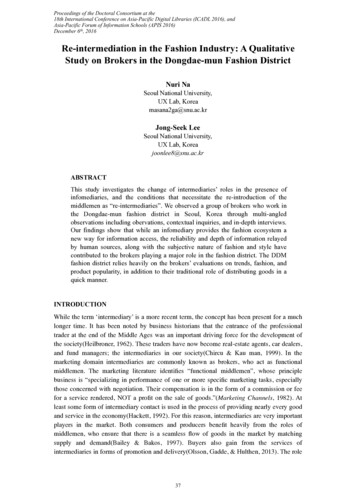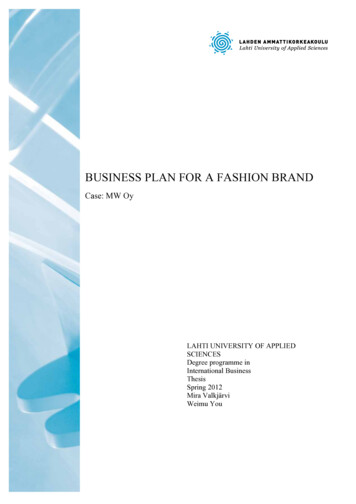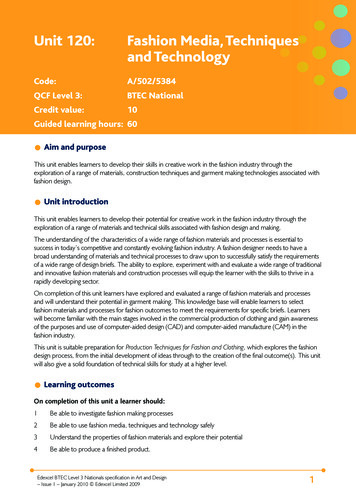
Transcription
Proceedings of the Doctoral Consortium at the18th International Conference on Asia-Pacific Digital Libraries (ICADL 2016), andAsia-Pacific Forum of Information Schools (APIS 2016)December 6th, 2016Re-intermediation in the Fashion Industry: A QualitativeStudy on Brokers in the Dongdae-mun Fashion DistrictNuri NaSeoul National University,UX Lab, Koreamasana2ga@snu.ac.krJong-Seek LeeSeoul National University,UX Lab, Koreajoonlee8@snu.ac.krABSTRACTThis study investigates the change of intermediaries’ roles in the presence ofinfomediaries, and the conditions that necessitate the re-introduction of themiddlemen as “re-intermediaries”. We observed a group of brokers who work inthe Dongdae-mun fashion district in Seoul, Korea through multi-angledobservations including obervations, contextual inquiries, and in-depth interviews.Our findings show that while an infomediary provides the fashion ecosystem anew way for information access, the reliability and depth of information relayedby human sources, along with the subjective nature of fashion and style havecontributed to the brokers playing a major role in the fashion district. The DDMfashion district relies heavily on the brokers’ evaluations on trends, fashion, andproduct popularity, in addition to their traditional role of distributing goods in aquick manner.INTRODUCTIONWhile the term ‘intermediary’ is a more recent term, the concept has been present for a muchlonger time. It has been noted by business historians that the entrance of the professionaltrader at the end of the Middle Ages was an important driving force for the development ofthe society(Heilbroner, 1962). These traders have now become real-estate agents, car dealers,and fund managers; the intermediaries in our society(Chircu & Kau man, 1999). In themarketing domain intermediaries are commonly known as brokers, who act as functionalmiddlemen. The marketing literature identifies “functional middlemen”, whose principlebusiness is “specializing in performance of one or more specific marketing tasks, especiallythose concerned with negotiation. Their compensation is in the form of a commission or feefor a service rendered, NOT a profit on the sale of goods.”(Marketing Channels, 1982). Atleast some form of intermediary contact is used in the process of providing nearly every goodand service in the economy(Hackett, 1992). For this reason, intermediaries are very importantplayers in the market. Both consumers and producers benefit heavily from the roles ofmiddlemen, who ensure that there is a seamless flow of goods in the market by matchingsupply and demand(Bailey & Bakos, 1997). Buyers also gain from the services ofintermediaries in forms of promotion and delivery(Olsson, Gadde, & Hulthen, 2013). The role37
Proceedings of the Doctoral Consortium at the18th International Conference on Asia-Pacific Digital Libraries (ICADL 2016), andAsia-Pacific Forum of Information Schools (APIS 2016)December 6th, 2016of intermediaries, however, have been reduced and altered significantly with the advance ofinformation technology(Howells, 2006).The Internet has brought the middleman to the digital space(Ordanini & Pol, 2001). Anew word combining ‘information’ and ‘intermediaries’ has been invented to properly captureits role and place. Fisher defines “information intermediaries or infomediaries” as who are“concerned with enabling access to information from multiple sources and engaged ininforming, aggregating, compiling, and signaling information.”(Fisher, 2010). Traditionalintermediaries were simply human agents who took on the task of collecting and dispersinginformation and products relevant to the market(Snehota & Gadde, 2001). Infomediaries areable to do this on a much broader scale with high e ciency: infomediaries are machine, afterall(Malone, Yates, & Benjamin, 1987). The reachability and accessibility of onlineinformation is a huge advantage. For example, local used-car dealerships cannot simplycompete with infomediaries like cars.com. The increasing information accessibility of thegeneral public is pushing intermediaries obsolete(Gellman, 1996).Despite these trends, at the Dongdae-mun Fashion District in South Korea, o inetraditional intermediaries absorb the infomediary role and become highly specialized to thelevel where they become a necessity for the market to function and thrive. Technology andthe Web are replacing intermediaries, but these human agents have found a way to adapt bytaking on additional tasks like gatekeeping and coaching on top of traditional intermediaryroles. In order to further investigate this new human-infomediary we incorporateobservations, contextual inquiries, and in-depth interviews in tune to the following questions: RQ1. How did the roles of human agents change with the arrival of infomediaries? RQ2. What are the information areas of human intermediaries that infomediaries are notable to replicate?- What are the characteristics of such information?The rest of the paper is organized in six sections. In Section 2, we provide furtherexplanation of the Dongdae-mun (DDM) Fashion District, the human-infomediary that wewill call as brokers, and the relation that this human-infomediary has with the market andpotential customers. Based on these observations, we detail our research methodology andapproach in Section 3. Findings and results from the research are presented in Section 4,followed by the discussion of our contributions and expandable issues in Section 5. Lastly,our work is summarized and concluded in Section 6.BACKGROUNDThe Dongdae-mun Fashion District and Korean Fast FashionThe Dongdae-mun (DDM) Fashion District can be traced back to 1905, where local shopstook in and modified uniforms and blankets from US G.I.s in the outskirts of GwangjangMarket. The assembly of the Pyunghwa Market in 1961 laid the first stone of the fashiondistrict, enabling the market to grow in size and quality. The building of the Art Plaza in 1990,and the following construction of the Milliore Building in 1998 has pushed the market to evenfurther heights. The market now is a booming center for all things clothing, from wholesale toretail businesses(Hong, 2007). This was possible because the DDM Fashion Market naturallyintegrated a steady production infrastructure as well. Fabric, subsidiary materials, and sewing38
Proceedings of the Doctoral Consortium at the18th International Conference on Asia-Pacific Digital Libraries (ICADL 2016), andAsia-Pacific Forum of Information Schools (APIS 2016)December 6th, 2016machines are all present inside the fashion district, and it is this link that has allowed DDM tobe what it is today(Lim, 2010). With over 30 million wholesale stores producing multipleproducts in batches, DDM is considered to be the place for fashion design, production,merchandising, and distribution(Choi, 2013).The closely-knit relation between wholesale stores and fabric/sewing factories allowsthe fashion district to speed up its production cycle. It can be said that DDM’s multi-itembatch production is similar to fast fashion, the nature of the two are vastly di erent(Lim,2010). Represented by brands such as ZARA and HM, fast fashion is spear-headed by bigcompanies that design, produce, and distribute small amounts of trendy clothing over a shortperiod of time. In contrast, wholesale merchants inside the DDM Fashion District are mostlyconsisted of four to five people and utilizes a Quick Response (QR) system: When a designedproduct falls out of favor, production is stopped immediately and production becomes gearedtowards more popular clothing(Jihyun, 2010). For example, if a dress worn by world-famousactress Song Hye-gyo in the K-drama “Descendants of the Sun” is gaining popularity,multiple versions of the dress will be out on display the very next day in the DDM FashionDistrict. Merchants and designers are able to get real-time feedback from customers, andproduction is always flexible and fast-paced(Eun Joo Park, 2012).The incorporation of internet technology has further accelerated the already-fastmanufacturing process. Internet shopping is huge in Korea. According to a market research in2013, Korea’s online market boasts 35.7 billion dollars in market share and is continuallygrowing(Kim, 2013). There are orders to be made and delivered, and with Korea’s busycultural repertoire (hurry hurry) and exceptionally accessible geological characteristics (asmall nation, where traveling from one end to another takes only eleven hours), there areexpectations in parcel delivery time (two business days) that must be met(Joon-Mann, 2010).In order for that to happen, deliveries from big wholesale stores to smaller retail stores mustbe almost instant. This is where our brokers come into play.Human Agents and InfomediariesThe definition of intermediaries are especially covered in the field of marketing and business.While the roles of intermediaries have changed over the course of history, the more traditionalroles can be boiled down to three main dynamics of traders, distributors, andproviders(Snehota & Gadde, 2001). Initially, intermediaries were big as traders. The lack ofspecialties of other occupations required intermediaries to be a jack-of-all-tradesprofessional(Heilbroner, 1962). Traders were able to connect customers to products, andproducts to customers by the sharing of information(Ramírez, Parthasarathy, & Gordon,2013). This intermediary bridges the gap between markets, facilitating interaction among itsmembers(Bayer, Geissler, & Roberts, 2011). This was the primary role of the intermediary,until the subsequent development of production technologies that came with the industrialrevolution pushed intermediaries from traders to distributors and providers.Intermediaries acting as distributors during and after the industrial revolution helpedproducers push the sudden uptick of production to customers. As more and more productswere readily available, it was up to the intermediary to push the products so that the marketwould generate a flow(Malone et al., 1987). Intermediaries were able to serve multiplemanufacturers, and some would start focusing on certain products that was better suited totheir customers. This manufacturer’s perspective of the middleman is what previous studies39
Proceedings of the Doctoral Consortium at the18th International Conference on Asia-Pacific Digital Libraries (ICADL 2016), andAsia-Pacific Forum of Information Schools (APIS 2016)December 6th, 2016mainly mention about intermediaries(Olsson et al., 2013). The reverse would also beapplicable, with the intermediary delivering the wants and needs of the customers to themanufacturers. The manufacturers would then again provide the goods that the customershave demanded. A cycle was created and maintained by intermediaries(Malone et al., 1987).This too, however, would change with the a new wave of technology.Technology and the changing of times have definitely forced intermediaries to changein order to survive. It can be argued that the most drastic changes have come with the rise ofinformation technology (IT) in the 1900s(Hagel & Singer, 1999). A new digital intermediarycalled infomediaries came into being armed with a vast information pool that would surelyoutperform traditional middlemen(Bakos, 1998). IT allowed the customer to be able tocontact the producer directly, establishing a direct contact which left out the middleman andthe services they brought(Vandermerwe, 1999). IT also introduced a better control of materialflows, further diminishing the roles of intermediaries(Hagel & Singer, 1999). Bleakconsequences were observed, with even some scholars arguing that “many intermediaries willdie out”(Pitt, Berthon, & Berthon, 1999). This process was even coined the term disintermediation by Gellman(Gellman, 1996). However, to much surprise, intermediaries notonly did not disappear, but also have took on more specified roles. Infomediaries andintermediaries would exist in harmony, unlike the unpromising predictions of many scholars.This phenomenon is equally observed in the DDM Fashion District. Here, wholesale andretail merchants have access to an infomediary known as the “New Products Market”. This iswhere all newly designed clothing are uploaded for ease of viewing and ordering. Once anorder is placed through this website, it is up to intermediaries to deliver the products betweenretail and wholesale stores. It may seem as a simple job and that the intermediary’s role hasbeen reduced, but as the investigation shows below that is not the case. It turns out thatintermediaries have a strategic and important role within the market such that the fashiondistrict may not function without them.RESEARCH METHODThe investigation was carried out over a three-month time period in three distinctive stages,starting from April to June of 2016. The participants of this study are working or hadexperience working as a broker at the Dongdae-mun Fashion District. After an initialobservation period of two weeks, contextual inquiry interviews were conducted with theresearch team following a broker throughout his workday. Final in-depth interviews wereconducted as the last step. A detailed description of each stage is as below.ObservationsA two-session observation period was held over two weeks at the Dongdae-mun FashionDistrict. Each session lasted over the entire work “night” (DDM brokers work schedule startslate evening, around 8pm and finishes around 9am), minus the last two hours where the mainworkload is finished and delivery packages are prepared. The first observation session wasfocused on the fashion district itself, with the people surveyed having included brokers aswell as retail and wholesale merchants. The second observation session was geared towardsthe merchants. Observation sessions were conducted in a non-intrusive manner.Contextual Inquiry40
Proceedings of the Doctoral Consortium at the18th International Conference on Asia-Pacific Digital Libraries (ICADL 2016), andAsia-Pacific Forum of Information Schools (APIS 2016)December 6th, 2016We conducted two contextual inquiry (CI) interviews with two current brokers. Due to thenature of the brokering job, it was only possible to conduct contextual inquiries with oneperson at a time. Each CI lasted over the entire work schedule, which ranges from eight to tenhours. Each CI session was conducted by following a broker over the course of the interview.The research team was dressed in appropriate attire to “blend in” with the people who work atthe fashion district. Both researchers participated fully as an apprentice to the broker, and tookpart fully in ordering, delivering, and Permission was granted to follow and film the brokerduring his work routine, and the footage was then analyzed and transcribed.In-depth InterviewsA total of six individuals were available for in-depth interviews. Due to the ratherspontaneous nature of the brokers’ work schedule, we were able to conduct three face-to-faceinterviews in groups of two after hours. Four individuals currently work as a broker at theDDM fashion district, and the remaining two have had prior experience working as a DDMbroker. The interviews conducted were based on semi-structured guidelines, and wererecorded under the participants’ agreement. The recorded interviews were then transcribed.FINDINGSOur findings show that brokers who work in the Dongdae-mun fashion district have a uniquework schedule, with the use of digital devices versus pen and paper strictly divided betweenthe time and kind of task. This divide proves to be a deciding factor in the brokers’ dual-roleas an intermediary and infomediary. For better understanding, we first start o with providing adetailed view on what a typical workday for a DDM broker is like.Work RoutineThe typical work schedule of a broker at the Dongdae-mun fashion district starts in theevening at around 8pm. Brokers check into their o ce and fire up their computers. The firsttask for them is to check their email and KakaoTalk accounts for orders. Orders are mostlybased of items listed in the “New Arrivals Market”. Experienced brokers organize orders bygrouping them by wholesale dealers while at the same time considering their route around thefashion district. Unfortunately for the newcomers, most of them figure out their routes forcollecting by trial and error. The phones are busy as the brokers start calling wholesalemerchants to relay the order sheet. Jargons and expressions unique to the fashion district is amust when placing orders. After a row with the phones and emails, the brokers are ready tohead out to the street. They take their printed-out order sheet along with pen and paper andhead out to retrieve the goods.Before they head on out and tackle the orders, they must deal with the enormousamount of returns. As mentioned earlier, the fashion district runs on the fast-paced quickresponse (QR) system, and many retailers end up returning a good amount of the orders theyplaced a few days ago. In order to avoid confusion, the brokers tend to take care of the returnsfirst, and then proceed to their daily order list. If the number of returns is too high, returningand retrieving orders are done simultaneously; they must finish their order list before sunrise,when the orders are loaded on to trucks and delivered to retailers before the start of the workday. Brokers at the DDM fashion district have to take care on average a thousand orders pershift. These orders are spread out over the entire fashion district and it is all too common forbrokers to climb up and down tall buildings and even retrace their paths. The sheer amount of41
Proceedings of the Doctoral Consortium at the18th International Conference on Asia-Pacific Digital Libraries (ICADL 2016), andAsia-Pacific Forum of Information Schools (APIS 2016)December 6th, 2016orders and complicated navigation of the market requires brokers to be smart and diligent,while also having the strength to take on the daunting size of orders — A single order mayeven weight up to 10 kilograms. For this reason, it is extremely rare to see women working asbrokers in the DDM.And because the need of both hands is critical, digital devices such as phones andtablets are usually put away. In contrast to popular belief, it is much more cumbersome for thebrokers to work while recording on their phones. This is why the use of pen and paper ispreferred by brokers. Things are done and recorded in their way instead of a standardizeddigital input. They incorporate wireless headsets to free up their hands during their runs, andtheir use of digital devices remain strictly to phone calls — activities that do not require theuse of hands. After each building is cleared of orders, brokers take the goods to a centralizedpick-up location and heads o to tackle the next batch of orders. It is interesting to note that nomonetary give and takes happen when the brokers pick up the products from the store. Costsare taken care of after the day is over, and little to none is recorded, with verbal exchangesbeing the majority of confirmations.It is through these runs where the exchange of information takes place. Whenreturning items, brokers give feedback to the merchants on the clothes’ quality, design, price,and so on. When taking in the goods listed on the orders, the brokers learn about the fashiontrends and can also give tips to retailers who put in orders about what is trendy and how manyof an item should one order. This kind of information is crucial for the broker to expand hiscustomer list, and also helps in matching retailers to wholesale merchants in the possiblefuture.New Roles for BrokersIn regards with the first research question of this investigation, we have found that in additionto the three traditional roles of intermediaries — traders, distributors, and providers — anadditional two roles can be identified: one as a matchmaker, and the others as a gatekeeper.The three tradition
multiple versions of the dress will be out on display the very next day in the DDM Fashion District. Merchants and designers are able to get real-time feedback from customers, and production is always flexible and fast-paced(Eun Joo Park, 2012). The incorporation of internet technology has further accelerated the already-fast manufacturing .











